Ribaldry and symbolism dominate San Diego Opera’s largely successful “The Marriage of Figaro”
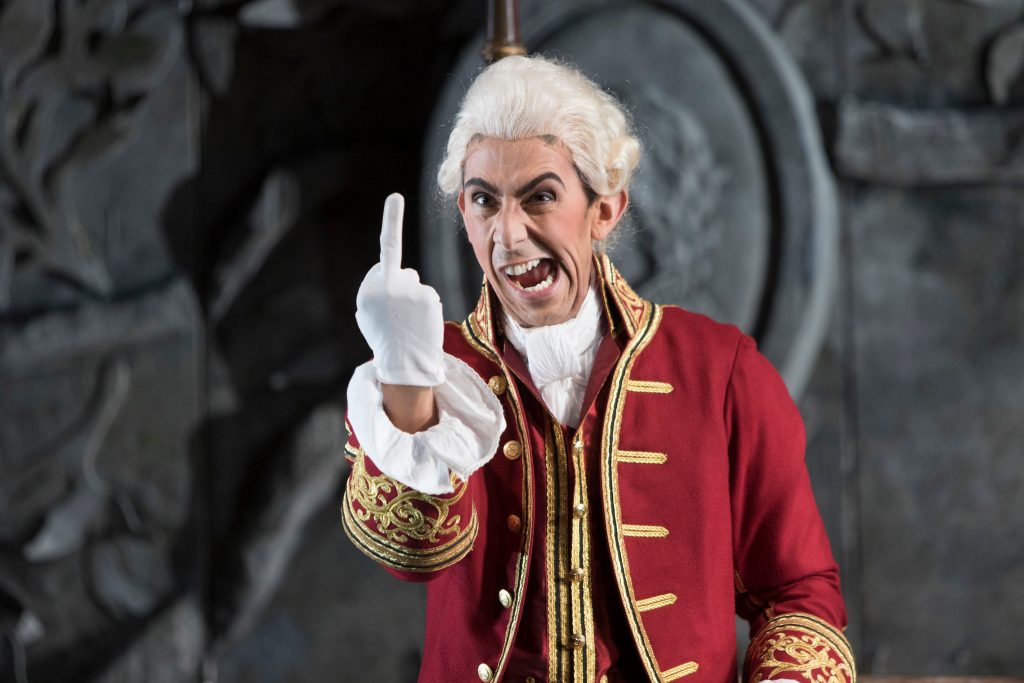
Bass baritone Evan Hughes is Figaro in San Diego Opera’s THE MARRIAGE OF FIGARO. October, 2018. Photo by J. Katarzyna Woronowicz Johnson.
San Diego Opera’s 2018-2019 Season Opens
Review by David Gregson
It is often alleged that San Diego opera-goers like their opera straight, unadulterated by the whims of Regietheater directors who transplant repertory classics to climes other than those envisioned by their composers or who impose fantastic interpretive concepts on the stories. They love their La bohèmes and have seen plenty of them by official counts, but please don’t put Rodolfo and Mimi on a space station as was staged in Paris last December.
So it may have been a relief to many in the audience for San Diego Opera’s season opener last night to have read beforehand in the San Diego Union-Tribune that they were going to see “period costumes” — and sure enough, that’s what they were. Very fine ones too. And by the end of the three-and-a-quarter hour evening, everyone seemed terribly happy and offered up warm applause and cheers during the curtain calls. The cast was exceptional. The leads sang superbly and looked their roles. The fine San Diego Symphony was in the pit.
But the production itself, directed by Steven Lawless, was far from a straightforward traditional “Figaro.” Comically vulgar sexual gestures and in-your-face symbolism dominated the proceedings. With Leslie Travers (who also created the costumes) as set designer, this was really a Regietheater show, although a benign one that inflicted few serious wounds on Mozart’s masterpiece. The main problems were stretches of the evening when the action was not one hundred percent clear.
In The Marriage of Figaro (Le nozze de Figaro), Mozart and his librettist, Lorenzo da Ponte, perhaps without ever realizing it, created an opera buffa for the ages — an almost perfect blending of musical form and text. The drama ranges from ribald farce to deep pathos, but the characters transcend the shenanigans and become real. Virtually every aria and ensemble is a jewel. And the sociopolitical elements carried over from the original Beaumarchais play are not, to be sure, subtle. The servant Figaro, later to become the famous Barber of Seville in Rossini’s masterpiece, intends to marry Susanna, a charming serving girl coveted by many, but most especially by Count Almaviva who intends to deprive her of her virginity before her wedding night. It his right as a feudal lord — his droit du seigneur — and although he had vowed to abandon it, lust has got the better of him. His Countess, Rosina, is long suffering because of her husband’s philandering, and two gorgeous arias, among other things, let us know that: “Porgi, amor” and “Dove sono.”
The opera also has a number of other characters important to the action: the hyper-romantic page, Cherubino, in love both with women and love in general and who has two memorably affecting gems to sing (“Non so più cosa son” and “Voi che sapete”); Dr. Bartolo and his housekeeper Marcellina, mischief makers (spoiler alert) who turn out to be Figaro’s parents thereby ruining Marcellina’s unwittingly incestuous marriage plans; Don Basilio, Susanna’s music master; and Barbarina, daughter of the Count’s gardener, Antonio. Cherubino, not incidentally, is a trouser role, a male part written for a female singer, in this case a mezzo-soprano. San Diego Opera is fortunate to have a superb actor/singer for this part, mezzo Emily Fons who inhabits her role to the hilt.
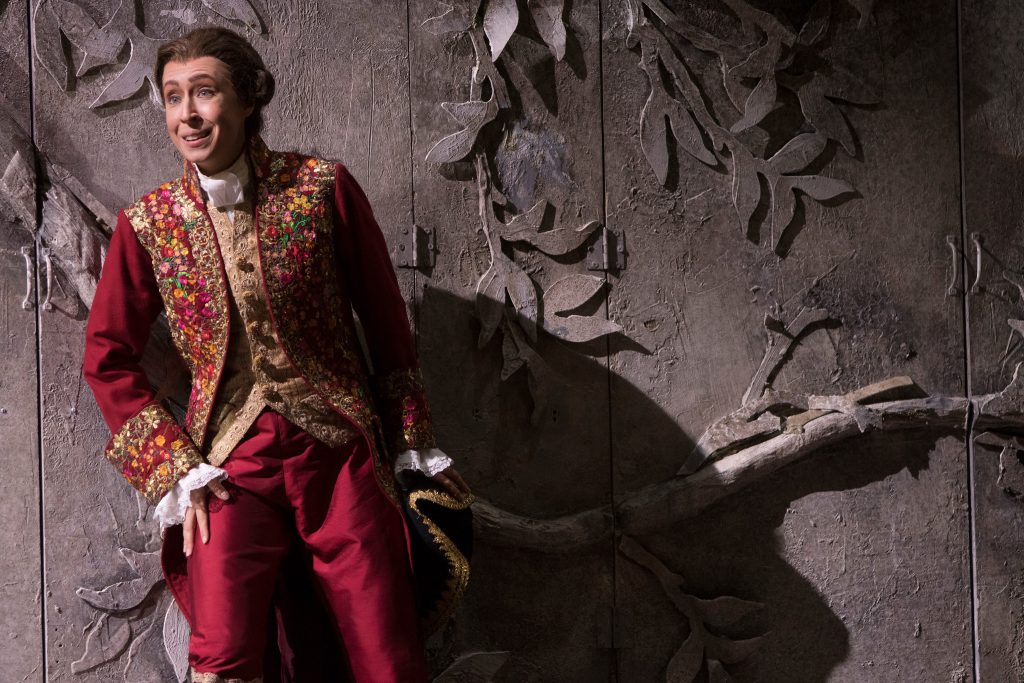
Mezzo soprano Emily Fons is Cherubino in San Diego Opera’s THE MARRIAGE OF FIGARO. October, 2018. Photo by J. Katarzyna Woronowicz Johnson.
So — to the production’s sex and symbolism. Cherubino mimes an erection, the Count and Countess romp in bed, Figaro gives us the finger and — well, there’s no end to the merry vulgarity. Singers have been instructed to telegraph every sexual thought that crosses their minds. Laughs and embarrassment are in about equal measure. We even get some foot fetishism in Act Four.
The sets have lots and lots of doors. Characters are compelled to go and in and out of them, often for no discernible reason. By the end of the opera’s run the doors will fall off their hinges from metal fatigue. And often the sets are free of any representation of a specific locale. One had to infer from the program that the opening of Act One takes place Figaro’s bedroom. One thing is clear, however: life passes us through many doors and we often are not sure what is or who is behind them. That’s my take on the damn doors.
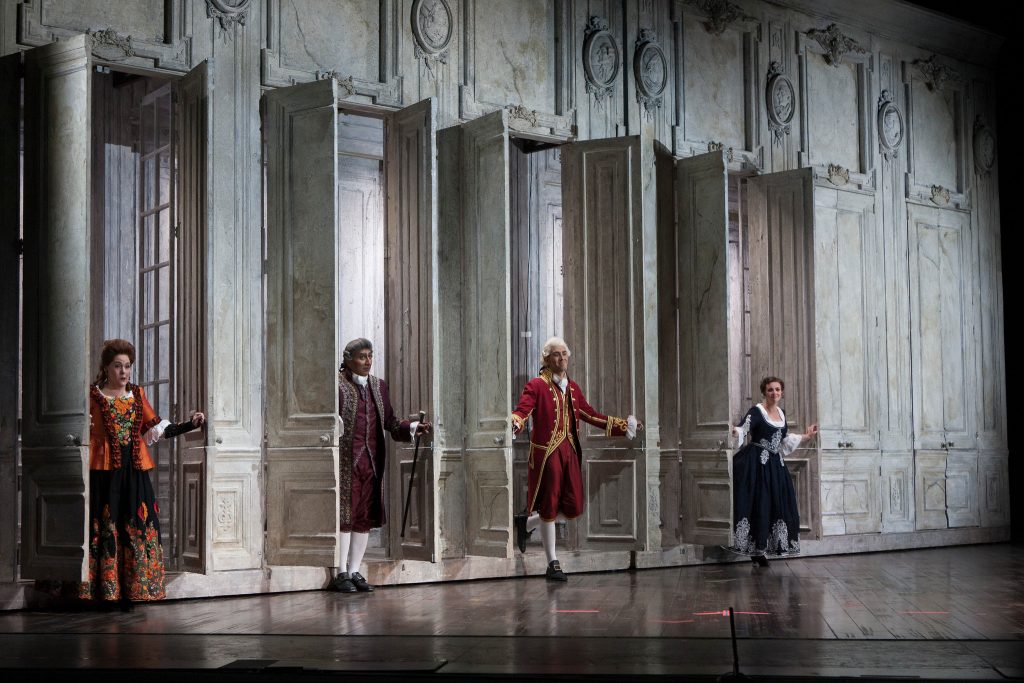
The doors. (L-R) Mezzo-soprano Susanne Mentzer is Marcellina, bass-baritone Ashraf Sewailiam is Dr. Bartolo, bass-baritone Evan Hughes is Figaro, and soprano Sarah Shafer is Susanna in San Diego Opera’s THE MARRIAGE OF FIGARO. October, 2018. Photo by J. Katarzyna Woronowicz Johnson.
All of Act One is dominated by a battleship gray wall embossed with an enormous family tree bearing oval aristocratic family cameos as fruit. A soon-to-be virtually ubiquitous bridal bed commands attention and continues to do so throughout most of the opera, often casting enormous shadows on the walls. “Figaro” is most certainly about sex, but also about folly, betrayal, social injustice, true love and human hearts. For me, the bridal bed as a focal point constitutes a reductionist approach condensing all to a rather obvious idea. The concept is not wrong, really; only overbearing.
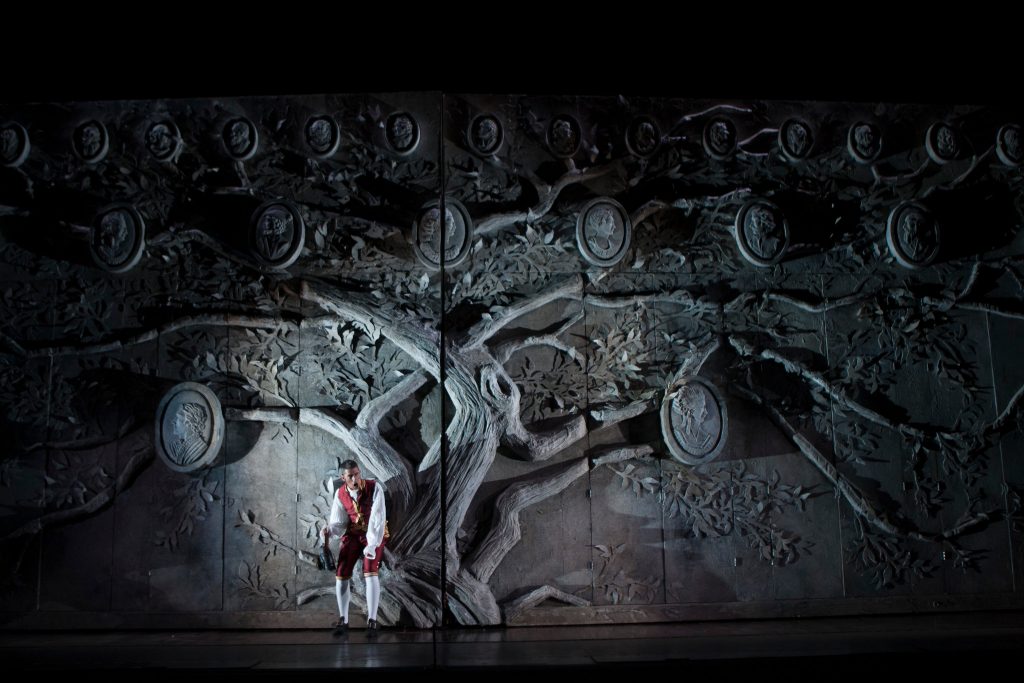
The Family Tree. With bass-baritone Evan Hughes as Figaro in San Diego Opera’s THE MARRIAGE OF FIGARO. October, 2018. Photo by J. Katarzyna Woronowicz Johnson.
Meanwhile, the set makes its own social commentary, and as the feudal order of the Almavivas crumbles, so do elements of the mise-en-scène. Previously oppressed servants remove and smash the cameos from the family tree and the always problematic final “garden scene” transpires on and about the rubble from the palace. The scene always produces production problems because the action is supposed to take place in the dark. Here there is plenty of light — and elsewhere lighting designer Thomas C. Hase provides many mysterious shifts of illumination throughout the action. Presumably these are to indicate moments of inner reflection for the characters.
Earlier in Act Three, Lawless brings in a menacingly masked bridal party in an apparent textual reference to the maskers in Mozart’s Don Giovanni. They stomp their country dance in a scary parody of a happy celebration. The revenge of the lower classes is at hand!
Fortunately the cast is first rate. We get two fine bass-baritones who know their way around a stage: Evan Hughes as Figaro and John Moore as the Count. Hughes projects a rich deep tone which belies his slender physique. Moore charms and broods — and his plea to Rosina for forgiveness in the final “Perdono” is deeply affecting. (I believe this moment was made famous by the movie Amadeus.) Hughes received a cheering ovation for his Act Four appeal to men in the audience to open their eyes to the treachery of women (“Aprite un po’ quegli occhi”). One hopes this reaction was not a serious referendum on the #MeToo movement. The lights came on in the house and Figaro made us all complicit. Earlier in Act Three Moore had captured our attention with a fine “Hai già vinta la causa” in which he feels trapped by Figaro’s machinations.
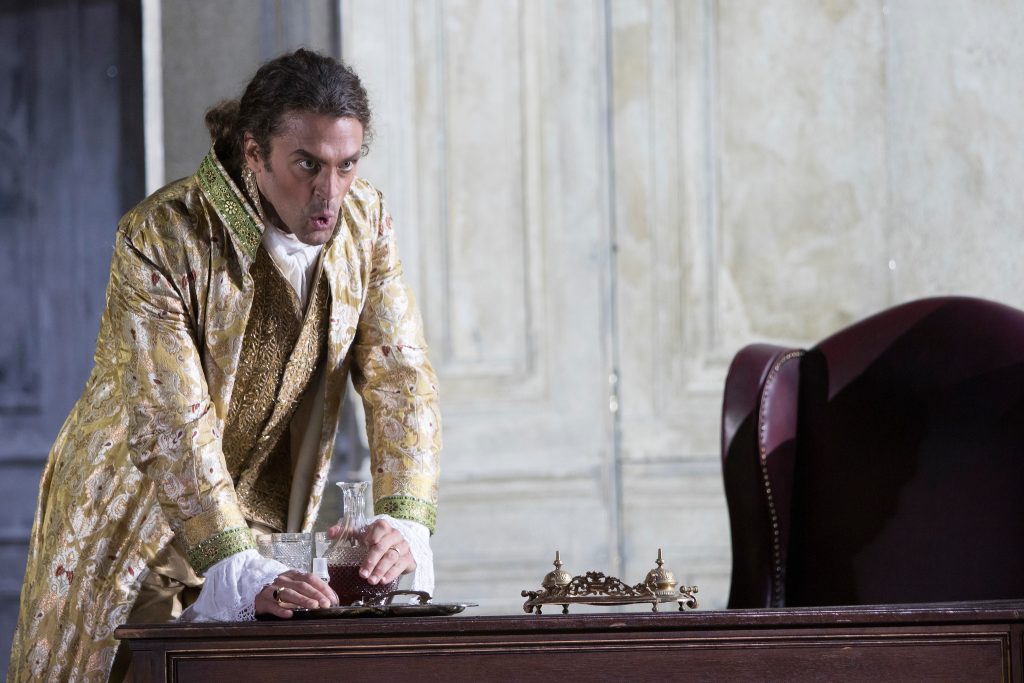
Baritone John Moore is Count Almaviva in San Diego Opera’s THE MARRIAGE OF FIGARO. October, 2018. Photo by J. Katarzyna Woronowicz Johnson.
For me the great highlight of the evening came with soprano Sarah Shafer (Susanna) singing a gorgeous “Deh vieni, non tadar” that was so beguiling as to make one unaware that Figaro is supposed be overhearing it. Shafer may be one of the best Susannas around these days. She was matched well with soprano Caitlin Lynch, someone very familiar with the role of the Countess — and it tells. She acquitted herself superbly in the two aforementioned arias. Her voice is plush with a pleasant but pronounced vibrato.
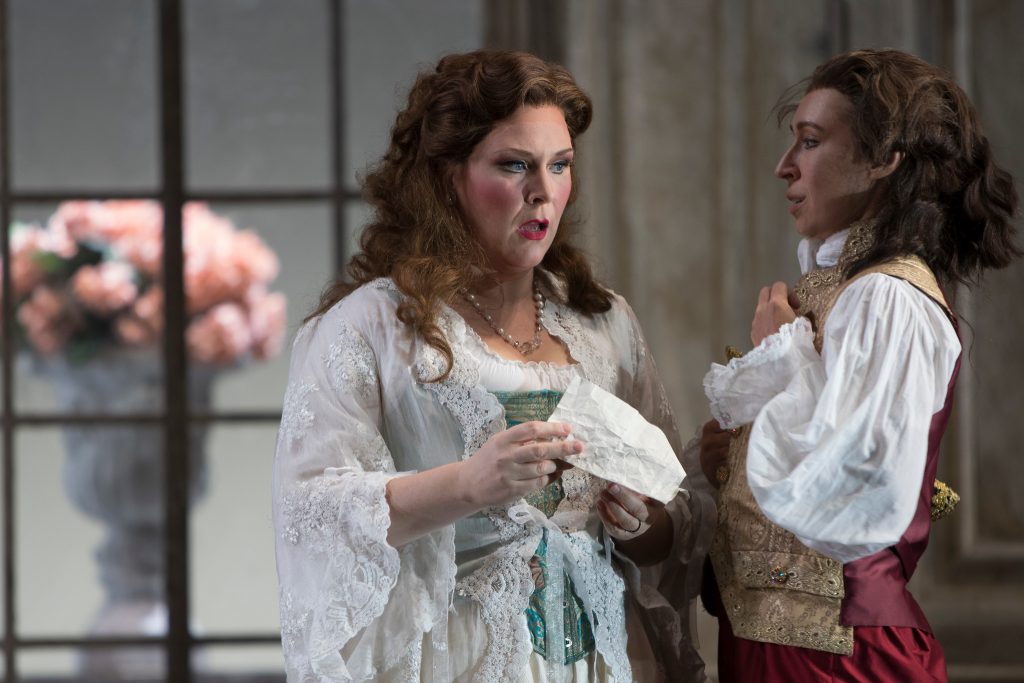
(L-R) Soprano Caitlin Lynch is Countess Almaviva and mezzo-soprano Emily Fons is Cherubino in San Diego Opera’s THE MARRIAGE OF FIGARO. October, 2018. Photo by J. Katarzyna Woronowicz Johnson
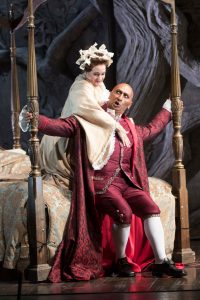
Mezzo-soprano Susanne Mentzer is Marcellina and bass-baritone Ashraf Sewailam is Dr. Bartolo in San Diego Opera’s THE MARRIAGE OF FIGARO. October, 2018. Photo by J. Katarzyna Woronowicz Johnson.
An old ham and always fun to see, mezzo- soprano Susanne Mentzer was hilarious as Marcellina, although she claimed to be feeling poorly and decided to sing all the recitatives but none of the arias. Soprano Julia Metzler performed the latter from the wings. Not an ideal situation, especially for opening night. Mentzer’s Bartolo was yet another bass-baritone, Ashraf Sewailam, who had impressed with his vengeance aria in the first act: “La vendetta”. Listed below are some more of the excellent cast.
Under the baton of conductor John Nelson, the San Diego Symphony served up a fleet and appropriately stylish rendering of Mozart’s score, although things went out of sync from time to time, especially in the ensembles and choral amassing. Chorus master Bruce Stasyna or Nelson may need to tighten things up. I could not see who was playing the harpsichord continuo, but whoever it was (Stasyna?) had a merry time offering witty little improvisations Mozart might have enjoyed.
CAST
John Moore — Count Almaviva
Evan Hughes — Figaro
Caitlin Lynch — Countess
Sarah Shafer — Susanna
Emily Fons — Cherubino
Susanne Mentzer — Marcellina
Ashraf Sewailam — Bartolo
Joseph Hu – Don Basilio and Don Curzio
Scott Sikon – Antonio
Lisa Frique – Barbarina
Erica Austin, Laura Bueno – Peasant Girls
Stephen Lawless — Director
John Nelson — Conductor
PERFORMANCES
SAT, OCT 20 AT 7PM
TUE, OCT 23 AT 7PM
FRI, OCT 26 AT 7PM
SUN, OCT 28 AT 2PM
San Diego Civic Theatre
1100 Third Ave, San Diego, CA 92101
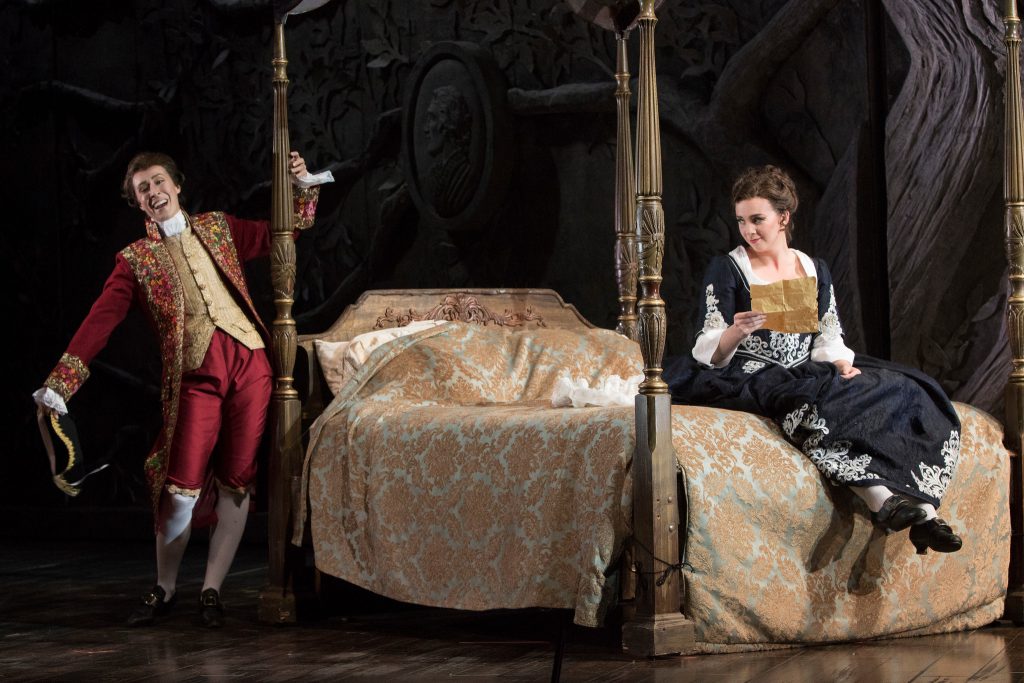
(L-R) Mezzo-soprano Emily Fons is Cherubino and soprano Sarah Shafer is Susanna in San Diego Opera’s THE MARRIAGE OF FIGARO. October, 2018. Photo by J. Katarzyna Woronowicz Johnson.
